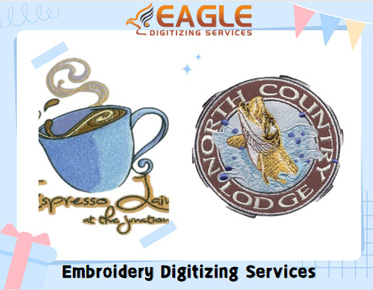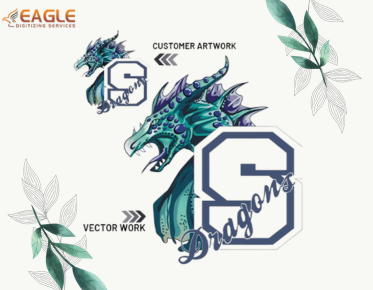Tiny Fonts, Big Impact: Essential Tips for Small Embroidery Success
Why Small Fonts Matter in Embroidery
In the world of embroidery, size truly does matter—but not in the way
you might think. Small fonts hold a unique power in embroidery, allowing you to
craft intricate and personalized designs that make a statement despite their
modest size. While larger fonts certainly grab attention, tiny fonts can add a
subtle, sophisticated touch to your creations. They can turn ordinary pieces
into extraordinary ones, infusing them with a level of detail and artistry that
is both impressive and delicate. Whether it's monogramming, logos, or custom
phrases, small fonts are a great way to convey personality and elegance while
maintaining your work's intricacy and craftsmanship.
How
Tiny Fonts Can Elevate Your Designs
When used correctly, tiny fonts can elevate your embroidery projects to a new level of sophistication.
These fonts are perfect for adding fine details that wouldn’t be possible with
larger letters. Think about it—smaller text allows for more creativity,
allowing you to experiment with different layouts and shapes, and even
incorporating small decorative elements within the text itself. Tiny fonts can
turn a simple design into something that feels bespoke and luxurious, adding an
extra layer of charm to items like handkerchiefs, cufflinks, or even fashion
pieces. It's all about creating something special with precision; small fonts
let you do just that.
Choosing
the Right Small Font for Your Project
The beauty of small fonts lies in their incredible versatility,
offering an elegant and refined look to any project. However, with this
versatility comes the responsibility of selecting the right font for your
specific needs. Choosing a font that is poorly suited for small sizes can
result in unreadable text or a loss of detail, compromising the overall
appearance of your design. A font that doesn’t hold up at smaller sizes will
not only look unclear but may even detract from the quality of your work. It’s
important to assess how the font behaves when scaled down and to consider
factors like legibility and clarity. Always choose a font that aligns with the
project’s style while maintaining the integrity of its form in a smaller size.
How
to Pick the Perfect Font Style
When selecting a font for your embroidery project, focus on something
that is clean and easily legible, especially when scaled down. Serif fonts with
thick strokes can become cluttered and difficult to read at smaller sizes,
causing confusion rather than adding style. Sans-serif fonts, with their clean
and straight lines, generally perform better in embroidery at small sizes
because they remain legible and crisp even with the finest details. For more
artistic or personalized designs, you might want to experiment with script fonts,
but be cautious—some tend to lose their elegance and clarity when reduced.
Testing your chosen font at a smaller scale is a crucial step in ensuring it
maintains both its legibility and visual appeal, so always preview the design
before finalizing it.
The
Best Fonts for Legibility at Small Sizes
When working with tiny fonts, legibility is paramount, as intricate
details can become lost or muddled if the font is not suited to small sizes.
Fonts like Arial, Helvetica, and Calibri are excellent choices for small text
because of their simple yet highly legible structure, which retains clarity
even when reduced. These fonts maintain their neatness and uniformity, allowing
for precise stitching. Additionally, fonts with rounded edges tend to perform
better at smaller sizes compared to sharp, angular fonts, which can become
jagged and unclear when embroidered. Consistent stroke weights across the
letters also contribute to better definition and readability, so avoid fonts
that have varying thicknesses that may distort the text during the stitching
process.
Fonts
to Avoid for Tiny Text
Some fonts, while beautiful in larger sizes, should be avoided for
small embroidery because they tend to lose their charm when reduced. Highly
decorative serif fonts or overly ornate script fonts can become unreadable at
smaller scales, as their intricate details and flourishes often get lost or distorted
in the stitching process. Fonts with heavy ornamentation and exaggerated
flourishes, which are eye-catching in larger designs, might make tiny text look
chaotic or unclear. Opting for simpler, streamlined fonts ensures that the text
remains legible and professional-looking even in smaller applications. The goal
is always to prioritize clarity and simplicity, ensuring that your text stands
out in a polished and readable way.
Preparing
Your Design for Small Embroidery
Once you've selected the ideal font, it's time to focus on preparing
the design for your embroidery machine, which is
a crucial step in ensuring a sharp, clean finish. This phase involves
fine-tuning various elements such as text size, spacing, and the overall
stitching technique, all of which directly impact the outcome. If these aspects
aren’t properly adjusted, your small font could easily become a tangled, blurry
mess. A meticulous approach during preparation will help avoid common pitfalls
such as thread breaks, misaligned stitching, or unclear text. Testing different
configurations and making necessary adjustments beforehand can save you time
and frustration, ensuring your design turns out exactly as you envision it.
Sizing
Your Text for Maximum Clarity
Correct sizing is one of the most important factors when working with
small fonts. To ensure clarity, it’s best to aim for a font height of at least
0.2 inches, as anything smaller risks becoming distorted or illegible during
the stitching process. While this is a general guideline, every project will
have different requirements depending on the fabric and stitching technique.
Always conduct a test stitch at the intended size to ensure the font retains
its shape and readability when embroidered. If the text is too small or doesn't
translate well on the fabric, you may need to adjust the sizing to achieve a
better result. Keep in mind that clarity is the goal—if the design looks
unclear at a small scale, don't hesitate to scale it up slightly for better
legibility.
Adjusting
Letter Spacing for Precision
The spacing between letters, also known as kerning, plays a crucial
role in ensuring your small fonts are easy to read. If the letters are too
close together, they can overlap, creating confusion or a blurry design. On the
other hand, excessive space between letters can make the text appear
disconnected and disjointed, affecting the overall flow of the design.
Adjusting letter spacing to ensure the right amount of space between each
character is essential for readability, especially at smaller sizes.
Fine-tuning kerning will ensure that each letter has enough room to stand out
while maintaining the cohesion of the design. Testing different spacing
adjustments can help you find the perfect balance, so the text is both clear
and visually appealing.
Choosing
the Right Thread Type for Small Fonts
Not all threads are suitable for small fonts, and using the wrong type
can result in unclear or distorted text. Thicker threads, while great for
larger designs, can overwhelm small text and obscure the fine details that make
the font legible. For small fonts, opt for fine-weight threads, such as
40-weight polyester or rayon, which allow for clean, sharp stitches without
overpowering the design. These lighter threads maintain the integrity of the
text and ensure it stays crisp and defined, even when embroidered at smaller
sizes. Additionally, choosing a high-quality thread is essential, as
poor-quality thread may fray or break, further complicating the process of
achieving a clear finish.
Mastering
Your Embroidery Machine Settings
Once you've prepared your design and selected the appropriate
materials, fine-tuning your embroidery machine settings is the next step in
ensuring that your small fonts are stitched to perfection. The right machine
settings can make all the difference in achieving a smooth, even finish with
minimal issues. Small fonts require precise adjustments to stitch density,
length, and machine speed to ensure that the stitches form clean lines without
distortion. Making these adjustments will help prevent thread breaks, fabric
puckering, or other common issues that can arise during embroidery. Don’t
forget to test your settings before starting the full design to ensure the
machine is working optimally for small-font embroidery.
Optimizing
Stitch Density for Small Fonts
Stitch density is a critical factor when working with small fonts, as
it determines how closely the stitches are packed together. Too many stitches
can cause the fabric to become overly dense or heavy, leading to a bulky
appearance or making the text harder to read. Conversely, too few stitches can
result in thin, incomplete text that lacks definition. To find the right
balance, you may need to adjust the stitch density to suit the complexity and
size of the font. A moderate stitch density ensures that each letter is fully
formed without being overpowered by excess stitching, giving the design a clean
and well-defined look. Don’t hesitate to experiment with different densities to
achieve the best effect.
The
Importance of Stitch Length and Tension
When working with small fonts, the length of the stitches is just as
important as their density. Shorter stitch lengths are generally better for
smaller, finer details, as they provide more control and precision. Longer
stitches can appear too bulky or uneven when embroidered at a small scale, so
it's essential to adjust the stitch length for optimum results. Tension also
plays a vital role in ensuring that the stitches remain consistent throughout
the design. Proper tension keeps the thread taut, preventing it from becoming
too loose or too tight, which can lead to uneven stitches or puckering in the
fabric. Adjusting both stitch length and tension to suit your design will help
maintain the clarity and neatness of small fonts.
How
to Adjust Speed for Fine Detail Work
When working with tiny text, machine speed becomes a crucial factor in
achieving the best results. Slowing down the embroidery machine gives it more
time to place each stitch with precision, which is essential when dealing with
fine details. Faster speeds can result in skipped stitches, uneven tension, or
even thread breakage, especially when working with small, delicate fonts. By
adjusting the speed to a slower setting, you allow the machine to execute each
stitch carefully and consistently, ensuring that your small fonts are
embroidered with clarity and accuracy. Testing the speed on a small sample
before starting your full design can help ensure that the stitching process
goes smoothly.
Choosing
the Right Fabric for Small Fonts
The fabric you choose plays a pivotal role in ensuring the success of
your small-font embroidery project. Fabrics with a smooth, even texture, such
as cotton, linen, or satin, are ideal for small fonts because they allow the
stitches to settle into the fabric neatly, resulting in clean, defined text.
Fabrics with excessive stretch or texture can make it difficult for the machine
to maintain the precision required for small fonts, leading to uneven stitching
and potentially blurred text. Choosing the right fabric ensures that your small
fonts retain their crispness and clarity, even after multiple stitches. Always
consider the fabric’s weight and texture in your design to make sure it
provides a stable base for your embroidery.
Why
Fabric Choice Affects Small Embroidery
Fabric selection is crucial when embroidering small fonts, as the texture and weight of the fabric can significantly impact the final result. Fabrics with a smooth surface provide a stable foundation for the embroidery, allowing the small fonts to appear crisp and defined. Fabrics with rough textures or a lot of stretch may cause the stitches to shift, resulting in blurry or misaligned text. For small-font embroidery, lightweight fabrics such as cotton and linen are preferred, as they offer the perfect balance of stability and softness. Fabric with too much stretch may cause the text to distort, making it harder to maintain precision when stitching small fonts. Choose your fabric carefully to ensure the final design is as sharp and professional as possible.



